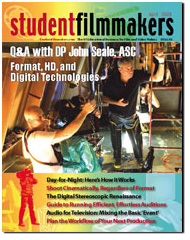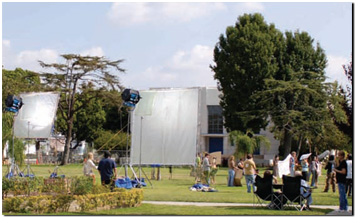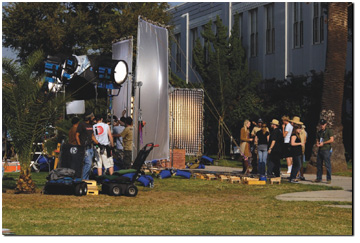HOW-TO, Techniques, & Best Practices Channel
| Lighting Period War Film, Shades of Hope: Separating Worlds through Color By Staff posted Nov 13, 2009, 20:52 |
Check out this article in the print edition of StudentFilmmakers Magazine, April 2008. More photos and gaffer sidebar included in print edition. Click here to get a copy and to subscribe >>
 Lighting
Period War Film, Shades of Hope
Lighting
Period War Film, Shades of Hope
Separating Worlds through Color
by Kevin Zanit
| Page 1 | 2 | 3 |
Brie Campbell, the writer and director of Shades of Hope approached me about the film while it was still being developed. I really liked the general idea of the story: a Vietnam War movie that travels back and forth between the war zones and back home. I immediately connected with it from a visual point of view and had a few ideas for the �look� I wanted for the film that came to me instinctively when hearing the story.

Behind the scenes of Shades of Hope.
As the script developed more, so did my ideas regarding the visual
aspects of the story. I knew I wanted the Vietnam and back home
parts of the story to have a stark contrast between them that
would make the viewer immediately aware of where they were in
the story. I shared some of my thoughts with Brie, and we were
very much on the same page.
For the Vietnam world, I wanted to really mute the color, and
because the pallet of Vietnam was predominately olive drab, I
wanted to embrace the monochromatic nature of that part of the
story. I also wanted the highlights to burnout quickly and knew
a bleach bypass to the film negative would give me both of the
above. Brie and I also decided that using wider lenses in Vietnam
and avoiding very tight close ups would help show how the soldiers
were somewhat engulfed by their surroundings. We also felt shooting
all the Vietnam sections handheld would also convey a sense of
unease.
We wanted the back home world to appear dramatically different.
The production design featured a much more colorful pallet. We
planned to use longer lenses to give us a pretty, shallow depth
of field look, and combined this with very smooth elegant camera
moves.

Lots of light defined the look of �back home.�
To really be comfortable with our Vietnam look, I knew a serious
round of testing would be important. I knew the bleach bypass
would give me the look I wanted with color and highlights but
did not necessarily want the extreme high contrast associated
with the process. To combat this, I planned to use low contrast
filters which would not only help lower the contrast but would
also interact with the really blown out highlights in a very interesting
way. I talked to Dan Sasaki at Panavision about what I was trying
to achieve, and remembered that he made up a few sets of special
lenses for Janusz Kaminski when shooting Saving Private Ryan called
�Flare Lenses�. He agreed that these could be a good option instead
of the filters and set out on finding them for me. These lenses
had their anti-flare coatings removed, thus allowing highlights
to easily flare the lens and lower the contrast.
I knew I wanted to test several combinations of film stocks (three
different Kodak stocks), lenses (two; the flare and Primo) and
lab processes (full skip bleach to the negative and process normal).
Deluxe did all of our lab work. We spent an entire day testing
around 100 different options and combinations of locations and
lighting methods. Frank DiPaola, the gaffer on the project was
crucial in his help with the tests. The results were screened
at Deluxe; I showed Brie my favorite, and she agreed. Thus, the
look for our Vietnam portion of the film was set: Kodak 5229,
which is a very low-contrast stock, with a full skip bleach to
the negative with Panavision�s heavy Flare lenses. This combination
of film stock and lens choices helped cancel out the high contrast
look of the bleach bypass and gave us what I would consider a
much more �normal� contrast range.
The back home portions of the movie were shot with Kodak 5217,
a very nice �snappy� film stock with Panavision Primo lenses,
also very good �snappy� lenses.
| Page 1 | 2 | 3 |